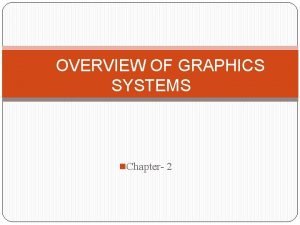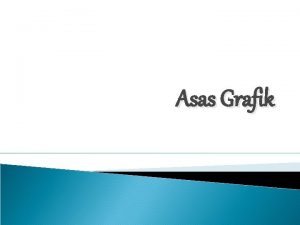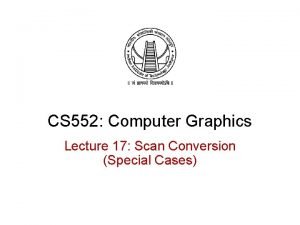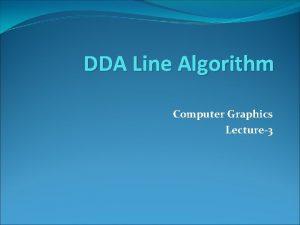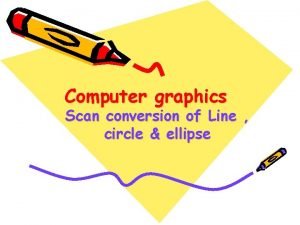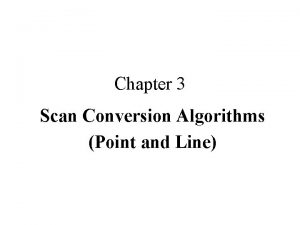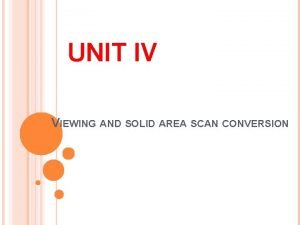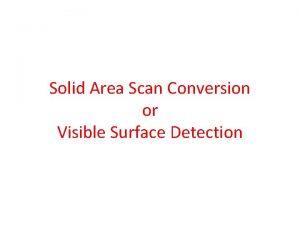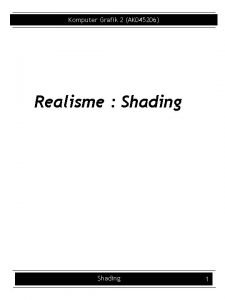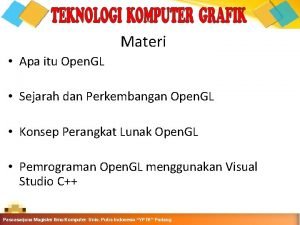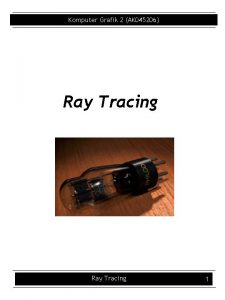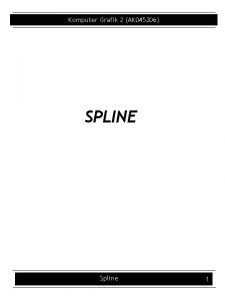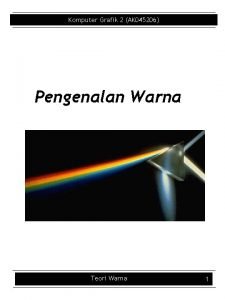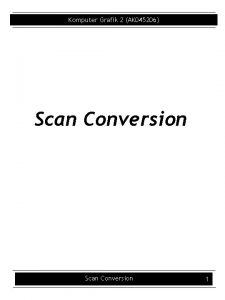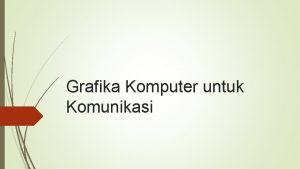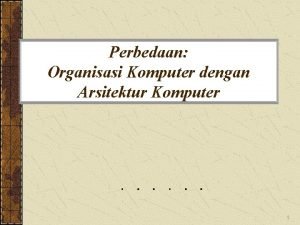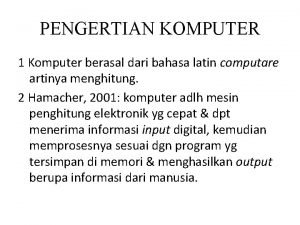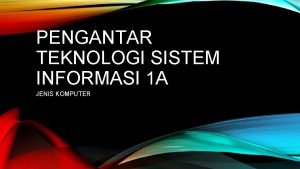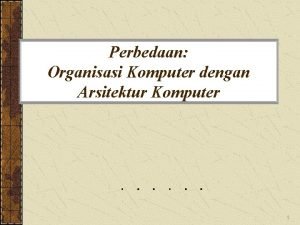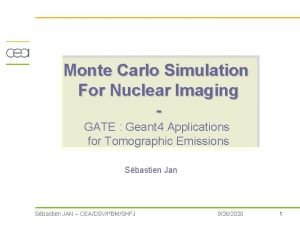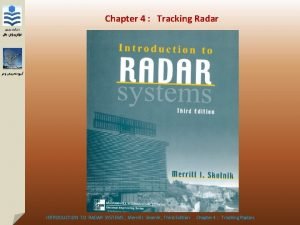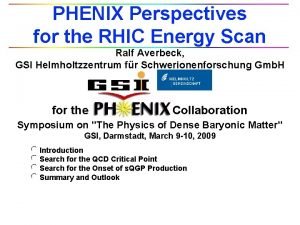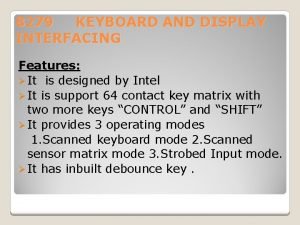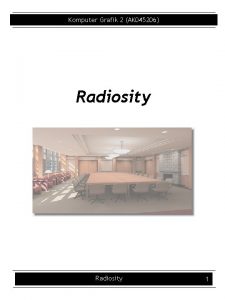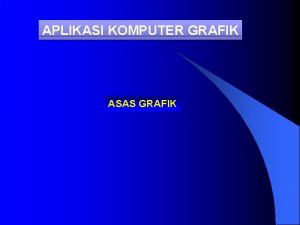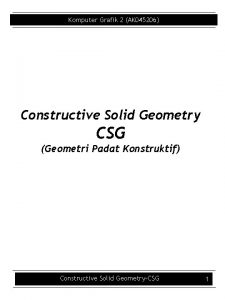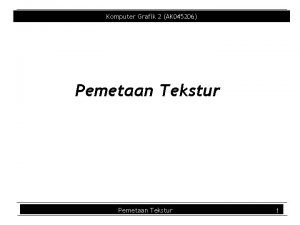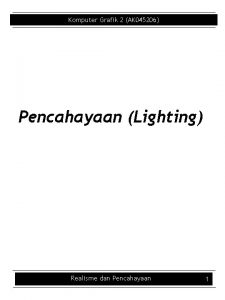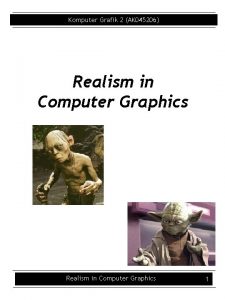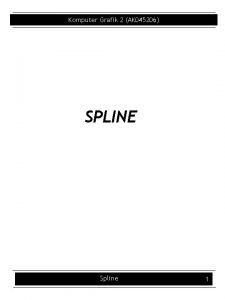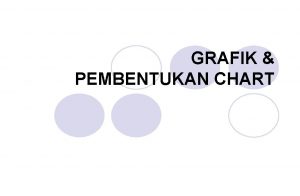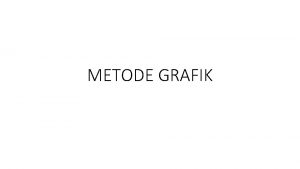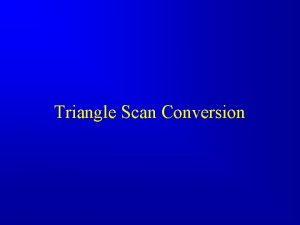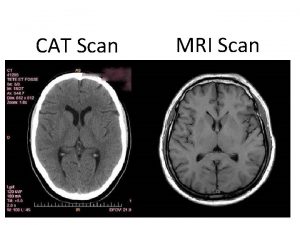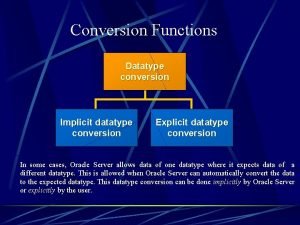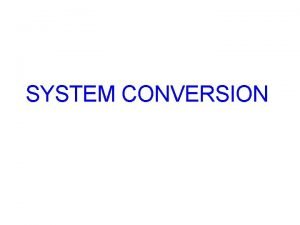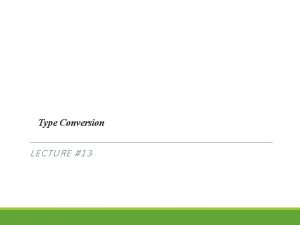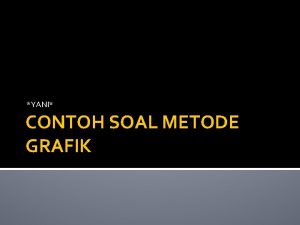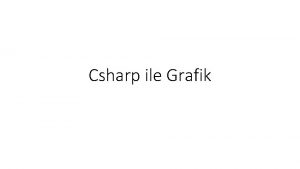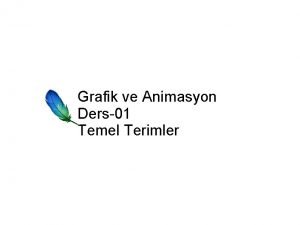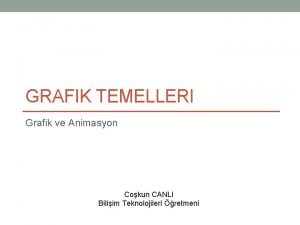Komputer Grafik 2 AK 045206 Scan Conversion 1































- Slides: 31

Komputer Grafik 2 (AK 045206) Scan Conversion 1

Komputer Grafik 2 (AK 045206) Outline • Scan Converting Lines – Incremental Algorithm – Midpoint Algorithm • Scan Converting Circle – Use Symetri – Incremental Algorithm – Midpoint Eight Circle Algorithm • Other Scan Conversion Problem – Pattern Primitive – Alligned Ellipses Scan Conversion 2

Komputer Grafik 2 (AK 045206) Scan Converting Lines Line Drawing • Draw a line on a raster screen between two points • What’s wrong with the statement of the problem? – it doesn’t say anything about which points are allowed as endpoints – it doesn’t give a clear meaning to “draw” – it doesn’t say what constitutes a “line” in the raster world – it doesn’t say how to measure the success of a proposed algorithm Problem Statement • Given two points P and Q in the plane, both with integer coordinates, determine which pixels on a raster screen should be on in order to make a picture of a unit-width line segment starting at P and ending at Q Scan Conversion 3

Komputer Grafik 2 (AK 045206) Finding the next pixel: Special case: • Horizontal Line: Draw pixel P and increment the x coordinate value by one to get the next pixel. • Vertical Line: Draw pixel P and increment the y coordinate value by one to get the next pixel. • Diagonal Line: Draw pixel P and increment both the x and the y coordinate by one to get the next pixel. • What should we do in the general case? – Increment the x coordinate by 1 and choose the point closest to the line. – But how do we measure “closest”? Scan Conversion 4

Komputer Grafik 2 (AK 045206) Vertical Distance • Why can we use the vertical distance as a measure of which point is closer? – because the vertical distance is proportional to the actual distance – how do we show this? – with congruent triangles (x 1, y 1) (x 2, y 2) • By similar triangles we can see that the true distances to the line (in blue) are directly proportional to the vertical distances to the line (in black) for each point • Therefore, the point with the smaller vertical distance to the line is the closest to the line Scan Conversion 5

Komputer Grafik 2 (AK 045206) Strategy 1 – Incremental Algorithm (1/2) The Basic Algorithm • Find the equation of the line that connects the two points P and Q • Starting with the leftmost point P, increment xi by 1 to calculate yi = mxi + B where m = slope, B = y intercept • Intensify the pixel at (xi, Round(yi)) where Round (yi) = Floor (0. 5 + yi) The Incremental Algorithm: • Each iteration requires a floating-point multiplication – therefore, modify the algorithm. • yi+1 = mxi+1 + B = m(xi + x) + B = yi + m x • If x = 1, then yi+1 = yi + m • At each step, we make incremental calculations based on the preceding step to find the next y value Scan Conversion 6

Komputer Grafik 2 (AK 045206) Strategy 1 – Incremental Algorithm (2/2) Scan Conversion 7

Komputer Grafik 2 (AK 045206) Problem with the Incremental Algorithm • Rounding integers takes time • Variables y and m must be a real or fractional binary because the slope is a fraction – special case needed for vertical lines Scan Conversion 8

Komputer Grafik 2 (AK 045206) Strategy 2 – Midpoint Line Algorithm (1/3) • Assume that the line’s slope is shallow and positive (0 < slope < 1); other slopes can be handled by suitable reflections about the principle axes • Call the lower left endpoint (x 0, y 0) and the upper right endpoint (x 1, y 1) • Assume that we have just selected the pixel P at (xp, yp) • Next, we must choose between the pixel to the right (E pixel), or the one right and one up (NE pixel) • Let Q be the intersection point of the line being scan-converted with the grid line x = xp +1 Scan Conversion 9

Komputer Grafik 2 (AK 045206) Strategy 2 – Midpoint Line Algorithm (2/3) NE pixel Q Midpoint M E pixel Previous pixel Choices for current pixel next pixel Scan Conversion 10

Komputer Grafik 2 (AK 045206) Strategy 2 – Midpoint Line Algorithm (3/3) • The line passes between E and NE • The point that is closer to the intersection point Q must be chosen • Observe on which side of the line the midpoint M lies: – E is closer to the line if the midpoint M lies above the line, i. e. , the line crosses the bottom half – NE is closer to the line if the midpoint M lies below the line, i. e. , the line crosses the top half • The error, the vertical distance between the chosen pixel and the actual line, is always <= ½ • The algorithm chooses NE as the next pixel for the line shown • Now, find a way to calculate on which side of the line the midpoint lies Scan Conversion 11

Komputer Grafik 2 (AK 045206) The Line equation as a function f(x): f(x) = m*x + B = dy/dx*x + B Line equation as an implicit function: • F(x, y) = a*x + b*y + c = 0 for coefficients a, b, c, where a, b ≠ 0 from above, y*dx = dy*x + B*dx so a = dy, b = -dx, c = B*dx, a > 0 for y 0 < y 1 Properties (proof by case analysis): • F(xm, ym) = 0 when any point M is on the line • F(xm, ym) < 0 when any point M is above the line • F(xm, ym) > 0 when any point M is below the line • Our decision will be based on the value of the function at the midpoint M at (xp + 1, yp + ½) Scan Conversion 12

Komputer Grafik 2 (AK 045206) Decision Variable d: • We only need the sign of F(xp + 1, yp + ½) to see where the line lies, and then pick the nearest pixel • d = F(xp + 1, yp + ½) - if d > 0 choose pixel NE - if d < 0 choose pixel E - if d = 0 choose either one consistently How to update d: - On the basis of picking E or NE, figure out the location of M for that pixel, and the corresponding value of d for the next grid line Scan Conversion 13

Komputer Grafik 2 (AK 045206) If E was chosen: M is incremented by one step in the x direction dnew = F(xp + 2, yp + ½) = a(xp + 2) + b(yp + ½) + c dold = a(xp + 1) + b(yp + ½) + c • Subtract dold from dnew to get the incremental difference E dnew = dold + a E = a = dy • Derive the value of the decision variable at the next step incrementally without computing F(M) directly dnew = dold + E = dold + dy • E can be thought of as the correction or update factor to take dold to dnew • It is referred to as the forward difference Scan Conversion 14

Komputer Grafik 2 (AK 045206) If NE was chosen: M is incremented by one step each in both the x and y directions dnew = F(xp + 2, yp + 3/2) = a(xp + 2) + b(yp + 3/2) + c • Subtract dold from dnew to get the incremental difference dnew = dold + a + b NE = a + b = dy – dx • Thus, incrementally, dnew = dold + NE = dold + dy – dx Scan Conversion 15

Komputer Grafik 2 (AK 045206) Scan Converting Circles • Version 1: really bad For x = – R to R y = sqrt(R • R – x • x); Pixel (round(x), round(y)); Pixel (round(x), round(-y)); • Version 2: slightly less bad For x = 0 to 360 Pixel (round (R • cos(x)), round(R • sin(x))); (0, 17) (17, 0) • HW: explain why these are bad. Scan Conversion 16

Komputer Grafik 2 (AK 045206) Version 3 — Use Symmetry R • Symmetry: If (x 0 + a, y 0 + b) is on the circle, so are (x 0 ± a, y 0 ± b) and (x 0 ± b, y 0 ± a); hence there’s an 8 -way symmetry. • But in a practical setting of considering pixel values, it depends on the fact that x 0 and y 0 are integers. Scan Conversion 17

Komputer Grafik 2 (AK 045206) Using the Symmetry • We will scan top right 1/8 of circle of radius R • It starts at (x 0, y 0 + R) • Let’s use another incremental algorithm with a decision variable evaluated at midpoint Scan Conversion 18

Komputer Grafik 2 (AK 045206) What we need for Incremental • Need a decision variable, i. e. , something that is negative if we should move E, positive if we should move SE (or vice versa). • Follow line strategy: Use the implicit equation of circle F(x, y) = x 2 + y 2 – R 2 = 0 F(x, y) is zero on the circle, negative inside it, positive outside • If we are at pixel (x, y), examine (x + 1, y) and (x + 1, y – 1) • Again compute F at the midpoint = F(midpoint) Scan Conversion 19

Komputer Grafik 2 (AK 045206) Decision Variable P = (xp, yp) M ME SE MSE • Evaluate F(x, y) = x 2 + y 2 – R 2 at the point • What we are asking is this: “Is positive or negative? ” • If it is negative there, this midpoint is inside the circle, so the vertical distance to the circle is less at (x + 1, y) than at (x + 1, y– 1). • If it is positive, the opposite is true. Scan Conversion 20

Komputer Grafik 2 (AK 045206) Incremental Computation, Again (1/2) • How should we compute the value of at successive points? • Answer: Note that is just and that is just Scan Conversion 21

Komputer Grafik 2 (AK 045206) Incremental Computation, Again (2/2) • So if we move E, update by adding 2 x + 3 • And if we move SE, update by adding 2 x + 3 – 2 y + 2. • Note that the forward differences of a 1 st degree polynomial were constants and those of a 2 nd degree polynomial are 1 st degree polynomials; this “first order forward difference, ” like a partial derivative, is one degree lower. Let’s make use of this property. Scan Conversion 22

Komputer Grafik 2 (AK 045206) Midpoint Eighth Circle Algorithm MEC (R) /* 1/8 th of a circle w/ radius R */ { int x = 0, y = R; int delta_E, delta_SE; float decision; delta_E = 2*x + 3; delta_SE = 2(x-y) + 5; decision = (x+1)*(x+1) + (y + 0. 5)*(y + 0. 5) –R*R; Pixel(x, y); while( y > x ) { if (decision > 0) {/* Move east */ decision += delta_E; delta_E += 2; delta_SE += 2; } else {/* Move SE */ y--; decision += delta_SE; delta_E += 2; delta_SE += 4; } x++; Pixel(x, y); } } Scan Conversion 23

Komputer Grafik 2 (AK 045206) Other Scan Conversion Problems • Patterned primitives • Aligned Ellipses Scan Conversion 24

Komputer Grafik 2 (AK 045206) Patterned Lines • Patterned line from P to Q is not same as patterned line from Q to P. P Q • Patterns can be geometric or cosmetic – cosmetic can be from a background or a pattern sequence • Cosmetic patterned line • Geometric patterned line Scan Conversion 25

Komputer Grafik 2 (AK 045206) Geometric Pattern vs. Cosmetic Pattern Geometric Pattern Scan Conversion Cosmetic Pattern 26

Komputer Grafik 2 (AK 045206) Aligned Ellipses • Equation is i. e, • Computation of and is similar • Only 4 -fold symmetry • When do we stop stepping horizontally and switch to vertical? Scan Conversion 27

Komputer Grafik 2 (AK 045206) Direction Changing Criterion (1/2) • When the absolute value of the slope of the ellipse is more than 1, viz: • How do you check this? At a point (x, y) for which F(x, y) = 0, a vector perpendicular to the level set is F(x, y) which is • This vector points more right than up when Scan Conversion 28

Komputer Grafik 2 (AK 045206) Direction Changing Criterion (2/2) • In our case, and so we check for i. e. • This, too, can be computed incrementally Scan Conversion 29

Komputer Grafik 2 (AK 045206) Problems with Aligned Ellipses • Now in ENE octant, not ESE octant • This problem is due to aliasing – much more on this later Scan Conversion 30

Komputer Grafik 2 (AK 045206) Referensi • • F. S. Hill, Jr. , COMPUTER GRAPHICS – Using Open GL, Second Edition, Prentice Hall, 2001 Andries van Dam, Introduction to Computer Graphics, Slide-Presentation, Brown University, 2003, (folder : brown. Uni) Scan Conversion 31
 The frame rate of a random scan architecture is 60-80 hz
The frame rate of a random scan architecture is 60-80 hz Kahoot pin
Kahoot pin Difference between random and raster scan
Difference between random and raster scan Cathode ray tube in computer graphics
Cathode ray tube in computer graphics Bahan grafik dan bukan grafik
Bahan grafik dan bukan grafik Ellipse scan conversion algorithm
Ellipse scan conversion algorithm Scan conversion also known as
Scan conversion also known as Scan conversion in computer graphics
Scan conversion in computer graphics Line equation in computer graphics
Line equation in computer graphics Scan conversion in computer graphics
Scan conversion in computer graphics Scan conversion algorithm
Scan conversion algorithm Solid area scan conversion means
Solid area scan conversion means Solid area scan conversion
Solid area scan conversion Komputer grafik
Komputer grafik Komputer grafik
Komputer grafik Apa itu vertex
Apa itu vertex Komputer grafik
Komputer grafik Komputer grafik
Komputer grafik Komputer grafik
Komputer grafik Komputer grafik
Komputer grafik Grafika komunikasi adalah
Grafika komunikasi adalah Struktur top level komputer
Struktur top level komputer Perbedaan organisasi dan arsitektur komputer
Perbedaan organisasi dan arsitektur komputer Kata komputer berasal dari bahasa
Kata komputer berasal dari bahasa Komputer untuk tujuan khusus termasuk komputer berdasarkan
Komputer untuk tujuan khusus termasuk komputer berdasarkan Perbedaan organisasi komputer dan arsitektur komputer
Perbedaan organisasi komputer dan arsitektur komputer Pancreatitis ct scan
Pancreatitis ct scan Ct scan detector
Ct scan detector Sequential lobing tracking radar
Sequential lobing tracking radar Phenix scan
Phenix scan Features of 8279
Features of 8279 Qr scan
Qr scan
